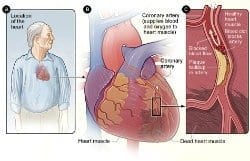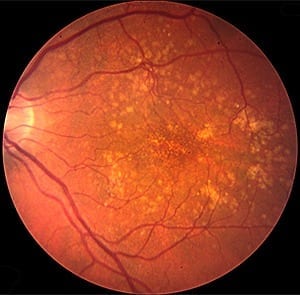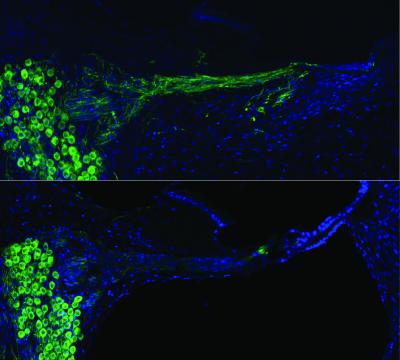
In animal studies, JH scientists have successfully prevented the development of atherosclerosis, the main cause of heart attacks and strokes and the number-one cause of death among humans
FAST FACTS:
- Johns Hopkins scientists have halted the development of atherosclerotic heart disease in animals by blocking the activity of a sugar-and-fat molecule residing in the membranes of cells.
- Using a widely available man-made compound called D-PDMP, the researchers prevented the buildup of fatty plaque and calcium deposits inside the blood vessels of mice and rabbits fed a high-fat, cholesterol-laden diet.
- Treatment with D-PDMP appears to work by altering a range of biological glitches that affect the body’s ability to properly use, transport and purge itself of cholesterol — the fatty substance that accumulates inside vessels and fuels heart disease.
Working with mice and rabbits, Johns Hopkins scientists have found a way to block abnormal cholesterol production, transport and breakdown, successfully preventing the development of atherosclerosis, the main cause of heart attacks and strokes and the number-one cause of death among humans. The condition develops when fat builds inside blood vessels over time and renders them stiff, narrowed and hardened, greatly reducing their ability to feed oxygen-rich blood to the heart muscle and the brain.
In a series of experiments, described April 7 in the journal Circulation, the Johns Hopkins team says it identified and halted the action of a single molecular culprit responsible for a range of biological glitches that affect the body’s ability to properly use, transport and purge itself of cholesterol — the fatty substance that accumulates inside vessels and fuels heart disease.
The offender, the researchers say, is a fat-and-sugar molecule called glycosphingolipid, or GSL, which resides in the membranes of all cells, and is mostly known for regulating cell growth. Results of the experiments, the scientists say, reveal that this very same molecule also regulates the way the body handles cholesterol.
The Johns Hopkins team used an existing man-made compound called D-PDMP to block the synthesis of the GSL molecule, and by doing so, prevented the development of heart disease in mice and rabbits fed a high-fat, cholesterol-laden diet. The findings reveal that D-PDMP appears to work by interfering with a constellation of genetic pathways that regulate fat metabolism on multiple fronts — from the way cells derive and absorb cholesterol from food, to the way cholesterol is transported to tissues and organs and is then broken down by the liver and excreted from the body.
“Current cholesterol-lowering medications tackle the problem on a single front — either by blocking cholesterol synthesis or by preventing the body from absorbing too much of it,” says lead investigator Subroto Chatterjee, Ph.D., a cardio-metabolic expert at the Johns Hopkins Children’s Center. “But atherosclerosis is a multi-factorial problem that requires hitting the abnormal cholesterol cycle at many points. By inhibiting the synthesis of GSL, we believe we have achieved exactly that.”
Specifically, the experiments showed that treatment with D-PDMP led to:
- a drop in the animals’ levels of so-called bad cholesterol or low-density lipoprotein, LDL;
- a drop in oxidized LDL, a particularly virulent form of fat that forms when LDL encounters free radicals. Oxidized LDL easily sticks to the walls of blood vessels, where it ignites inflammation, damaging the vessel walls and promoting the growth of fatty plaque;
- a surge in good cholesterol or high-density lipoprotein, HDL, known to counteract the effects of LDL by mopping it up; and
- a significant drop in triglycerides, another type of plaque-building fat.
The treatment also prevented fatty plaque and calcium deposits from building up inside the animals’ vessels. These effects were observed in animals on a daily D-PDMP treatment even though they ate a diet made up of 20 percent triglycerides — the human equivalent of eating a greasy burger for breakfast, lunch and dinner. In addition, the researchers say, D-PDMP appears to precision-target the worst byproducts of aberrant cell growth signaling, such as oxidized LDL and the activity of certain chemicals that fuel vessel inflammation, without altering cell growth itself.
D-PDMP, which is already widely used in basic research to experimentally block and study cell growth and other basic cell functions, is deemed safe in animals, the investigators say. For example, animals in the current study had no side effects even when given D-PDMP doses 10 times higher than the minimum effective dose, the study found. The research team is currently designing a compound drug with D-PDMP, which they soon plan to test in other animals and, eventually, in humans.
Mice used in the experiments were genetically engineered to lack a protein essential in the breakdown of fats and thus were predisposed to atherosclerosis. The researchers fed the animals a high-fat diet over the course of several months, but also gave a third of the animals a low-dose of D-PDMP. They gave a double dose of the same inhibitor to another third and placebo to the rest.
When scientists measured the thickness of the animals’ aortas — the body’s largest vessel and one that carries blood from the heart to the rest of the body — they found striking differences among the groups. As expected, the aortas of mice that got placebo had grown thicker from the accumulation of fat and calcium deposits inside them. The aortas of mice on low-dose D-PDMP, however, were significantly thinner with little to no obstruction. To the researchers’ surprise, Chatterjee says, mice eating high-fat foods and treated with high-dose D-PDMP had nearly pristine arteries free of obstruction, indistinguishable from those of healthy mice.
The Latest on: Atherosclerosis
[google_news title=”” keyword=”Atherosclerosis” num_posts=”10″ blurb_length=”0″ show_thumb=”left”]
via Google News
The Latest on: Atherosclerosis
- Scientists find cancer-like features in atherosclerosis, spurring opportunity for new treatment approacheson April 30, 2024 at 11:46 am
Researchers have discovered that the smooth muscle cells that line the arteries of people with atherosclerosis can change into new cell types and develop traits similar to cancer that worsen the ...
- These 10 Weight Loss Drugs Like Ozempic Can Work, but Are They Safe?on April 30, 2024 at 11:30 am
Research has shown some benefits to different types of weight loss drugs. Here’s how they work — and the potential side effects to be aware of.
- New study reveals cancer-like features in atherosclerosison April 30, 2024 at 11:11 am
U.S. researchers have discovered that the smooth muscle cells that line the arteries of people with atherosclerosis can change into new cell types and develop traits similar to cancer that worsen the ...
- Is Algae Oil the New Fish Oil?on April 30, 2024 at 10:35 am
WHILE THE IDEA of algae oil sounds pretty gross to us, the substance has been popping up left and right online recently. Could something as repulsive sounding as oil made from algae really have enough ...
- Everything You Need to Know About Algae Oilon April 30, 2024 at 10:35 am
“Algae oil can also have benefits for the skin,” says Zenker, citing this research. “Omega-3 fatty acids help maintain the skin's integrity, reduce the effects of aging, and may improve conditions ...
- What your feet can tell you about your healthon April 30, 2024 at 10:01 am
From skin to hair, scabs and even tears, the external appearance of the body can offer clues about the state of your health.
- Highlights in Atherosclerosis and Lipid Management From ACC 2024on April 29, 2024 at 2:07 pm
Lipid highlights from ACC 2024 included positive outcomes for bempedoic acid in statin-intolerant patients and for an inclisiran-first strategy in those with atherosclerosis.
- Why climbing stairs improves longevity, heart healthon April 29, 2024 at 11:55 am
Studies suggest that this "vertical exercise" has big benefits for cardiovascular and respiratory health. How many stairs make a difference?
- Study details finding of plastic in arteries of patients with atherosclerosison April 29, 2024 at 11:36 am
Plastic bottles floating in the ocean. A straw caught inside a sea turtle’s nose. The stomach contents of fish and whales filled with plastic waste. The problem of forever plastics isn’t something new ...
- Abatacept may decelerate progression of atherosclerosis in RA patients with CVD: Studyon April 28, 2024 at 8:00 pm
Researchers have found that abatacept treatment may benefit patients with rheumatoid arthritis (RA) who have a high risk of cardiovascular disease, according to a study published in ...
via Bing News










